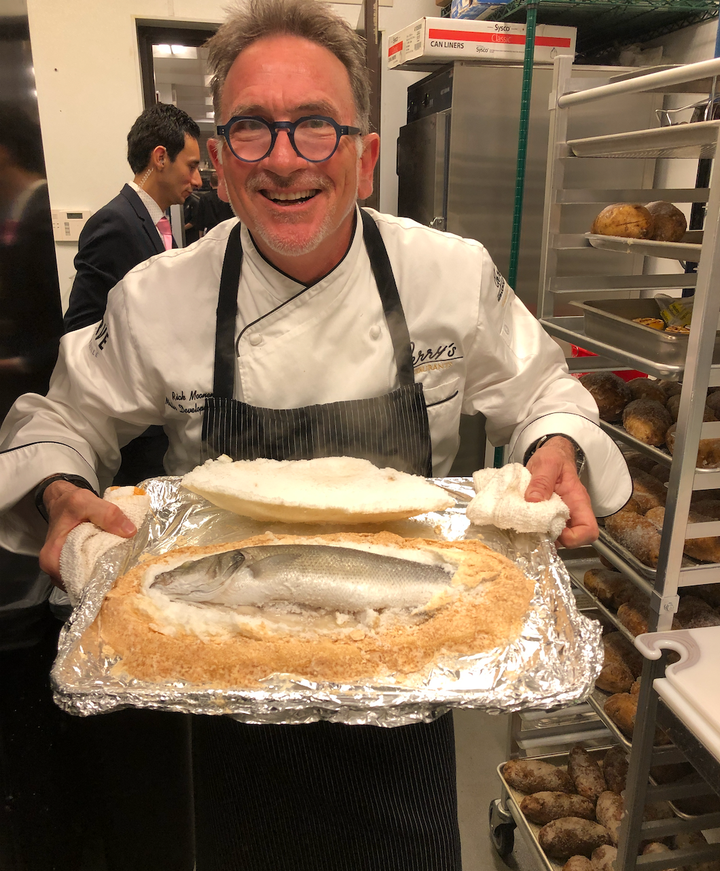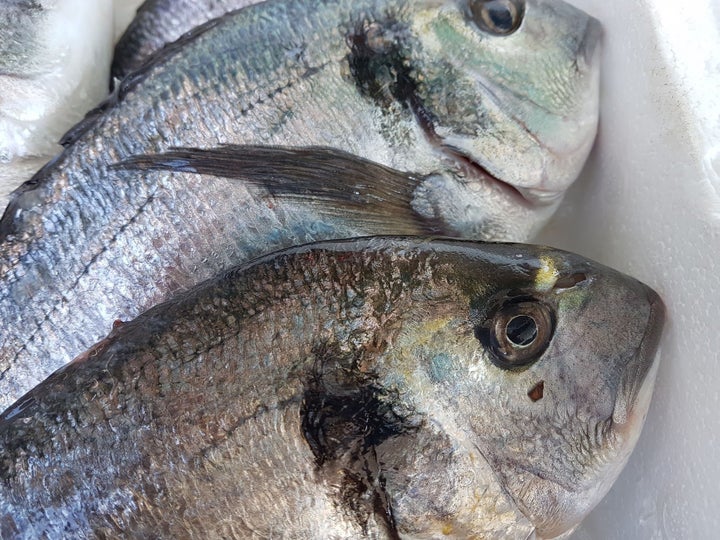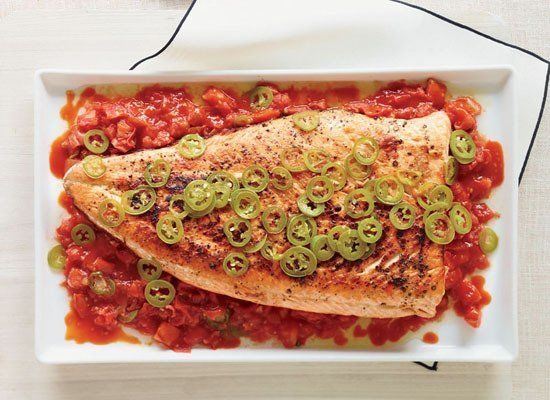
Maybe it’s the glassy eyes staring back at you. Maybe you don’t know what to do with the skin, the fins and the guts. Maybe it’s fear of screwing up and wasting the entire fish. For some home cooks, the idea of preparing a whole fish stirs feelings of culinary inferiority, to the point that they don’t even attempt it.
Yet other folks below the chef level savor the chance to cook a whole fish. They know it has a lot more flavor than a fillet and, when presented tableside, will evoke oohs and aahs from dinner guests.
According to celebrity chef Rick Moonen, veteran of Bravo’s “Top Chef Masters” and author of Fish Without a Doubt, there’s no reason for any cook to fear a whole fish, especially if you keep it simple.
Moonen, who has been dubbed the “Godfather of Sustainability” for his advocacy of sustainable seafood and fishing practices, is now master development chef for Perry’s Restaurant Group in Houston.
He shared with HuffPost the steps — from market to table — for preparing and serving a whole oven-roasted branzino, one of the easiest fishes to cook whole.
Step 1: Know Thy Fishmonger
If you aim to make fish a frequent star of your culinary repertoire, Moonen said it’s a good idea to make friends with your fishmonger. Whether you’re lucky enough to have a fresh fish market nearby or you’re shopping at your local grocery store, you should get to know the person behind the counter and ask for their advice on storage, handling and preparation.
If you don’t run into the same person at the fish counter all or most of the time you buy fish, it’s time to find a new source. “Ordering, handling and selling fish should be the job of the person behind the counter,” Moonen told HuffPost. “If it’s clear that they don’t know much about fish and are only there because that’s the shift they got that day, move on.”

Moonen said the fish counter should have a salty ocean smell, not a noticeably fishy odor. The whole fish for sale should retain their color and shine, with scales and skin intact. Eyes should be bright and not sunken in. “Basically,” he said, “the fish should look like it’s still alive.”
Your fishmonger should be able to tell you where the fish came from, whether it’s wild-caught or farm-raised and, if the fishmonger is really honest, how long it’s been there. “If the fish is on sale, you’d better ask to smell it first,” Moonen said, “because the freshest fish is usually not what goes on sale first.”
Ask the fishmonger to clean the scales and gut the fish, removing its internal organs. That leaves you with a lot less messy prep when you get home.
Step 2: Get Your Hands Dirty
Even if your fishmonger gutted the fish, you still have some work to do at home. You’ll need to rinse out the body cavity to make sure no traces of entrails remain, which per Moonen would give the cooked fish a bitter taste. With a pair of kitchen scissors, trim off the fins. Clean up any stray scales by running the blade of a sharp knife in the opposite direction of the scales, which will shave them off. Rinse the fish a final time and pat it dry with towels. Then set it on a baking sheet that’s lined with cooking parchment.
Next, prepare a mix of chopped herbs to stuff in the fish. The mix can consist of garlic, parsley, thyme, oregano and/or rosemary, plus salt and pepper. Stuff the herb mix into the cavity of the fish. Drizzle the outside of the fish with olive oil and then a liberal dose of salt. Bake it for about 20 minutes in an oven preheated to 425 degrees Fahrenheit.
Once the fish is in the oven, Moonen advises, “Don’t touch it. Don’t turn it. Don’t poke it. Don’t mess with it. Just let it cook.”
The fish is done when the skin is crispy and appears to pull away from the body. Cooking times can differ so you do have to watch it. But generally, a 1-pound branzino takes about 20 to 30 minutes.
Step 3: Present The Fish Like A Boss
Presenting a whole baked fish at the table tends to impress dinner guests ― especially if you’ve never done it before.
“In the restaurant, we typically serve the fish tableside, debone it and remove all the spare parts so the customer doesn’t have to deal with it,” Moonen said. “But if I serve whole fish at my home, it’s every diner for themselves.”

So you can present an individual fish on each person’s plate and leave the experienced to debone it themselves, instruct the newbies on how to proceed or do it yourself for the squeamish. In any case, there are a few tricks to making sure you get the most meat out of a fish without massacring it:
For branzino, start by cutting with a knife along the spine of the fish to free the skin.
Gently peel the skin back to expose the top fillet.
Using a small spatula or a spoon with the bowl facing down, gently separate the top fillet from the bones, starting from just behind the head and working toward the tail. Lift the fillet out onto the plate. “If it falls apart,” Moonen said, “don’t worry. It’s still gonna taste good.”
From the tail end, lift the bones out in one piece, using a fork o spoon to nudge them free from the bottom fillet. Discard the bones.
Slide the bottom fillet away from the skin and onto the plate. Discard the skin (“unless you want to eat it,” Moonen said), the head and any remaining bones.
If you or some of your guests just can’t abide that fish-eye stare, you can cut off the head before you bring the fish to the table. “To me, that’s kinda like eating your oysters already out of the shell,” Moonen said. “It just doesn’t feel right. But if you must, make sure you use a sharp knife and cut right behind the gill to waste as little of the flesh as possible.”
Once you’ve cooked your first whole fish and realize how easy it is, you might want to try experimenting with some fancy-schmancy recipes that will really impress your guests, like Moonen’s wow-worthy (but disarmingly easy) salt-crusted sea bream. That technique also works great with branzino.
